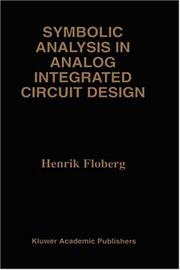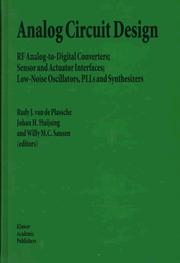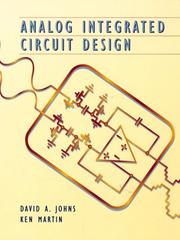| Listing 1 - 8 of 8 |
Sort by
|
Book
Year: 1997 Publisher: Boston ; Dordrecht ; London Kluwer Academic Publishers
Abstract | Keywords | Export | Availability | Bookmark
 Loading...
Loading...Choose an application
- Reference Manager
- EndNote
- RefWorks (Direct export to RefWorks)

ISBN: 0792399692 Year: 1997 Publisher: Boston (Mass.) : Kluwer academic,
Abstract | Keywords | Export | Availability | Bookmark
 Loading...
Loading...Choose an application
- Reference Manager
- EndNote
- RefWorks (Direct export to RefWorks)
Linear integrated circuits --- Symbolic circuit analysis. --- Design and construction --- Data processing.
Book

Year: 1997 Publisher: [Place of publication not identified] Institute of Electrical and Electronics Engineers
Abstract | Keywords | Export | Availability | Bookmark
 Loading...
Loading...Choose an application
- Reference Manager
- EndNote
- RefWorks (Direct export to RefWorks)
Linear integrated circuits --- Mixed signal circuits --- Congresses --- Design and construction --- Congresses --- Design and construction

ISBN: 0792399684 1441951857 1475726023 9780792399681 Year: 1997 Publisher: Boston Kluwer
Abstract | Keywords | Export | Availability | Bookmark
 Loading...
Loading...Choose an application
- Reference Manager
- EndNote
- RefWorks (Direct export to RefWorks)
Linear integrated circuits --- Electronic circuit design. --- Circuits intégrés linéaires --- Circuits électroniques --- Design and construction. --- Conception et construction --- Calcul --- Electronic circuit design --- Design and construction --- Congresses --- -Linear integrated circuits --- -Linear ICs --- Analog integrated circuits --- Electronic circuits --- Design --- -Congresses --- Linear ICs --- Design and construction&delete& --- Electronic circuits. --- Electrical engineering. --- Circuits and Systems. --- Electrical Engineering. --- Electric engineering --- Engineering --- Electron-tube circuits --- Electric circuits --- Electron tubes --- Electronics --- Linear integrated circuits - Design and construction - Congresses --- Electronic circuit design - Congresses
Book

Year: 1997 Publisher: [Place of publication not identified] Institute of Electrical and Electronics Engineers
Abstract | Keywords | Export | Availability | Bookmark
 Loading...
Loading...Choose an application
- Reference Manager
- EndNote
- RefWorks (Direct export to RefWorks)

ISBN: 0471144487 9780471144489 Year: 1997 Publisher: New York, N.Y. Wiley
Abstract | Keywords | Export | Availability | Bookmark
 Loading...
Loading...Choose an application
- Reference Manager
- EndNote
- RefWorks (Direct export to RefWorks)
IC (integrated circuit) --- Electronics --- ontwerpen --- Linear integrated circuits --- Design and construction --- 621.3'7 --- -621.382 --- CMOS complementary metal oxide semiconductor --- D/A omzetting --- IC integrated circuits --- SPICE --- analoge schakelingen --- analoog ontwerp --- comparatoren --- elektronica --- elektrotechniek --- filters --- opamps --- phase-locked loops --- Linear ICs --- Analog integrated circuits --- Electrical engineering--?'7 --- Halfgeleiders --- Design and construction. --- 621.3'7 Electrical engineering--?'7 --- 621.382 --- Linear integrated circuits - Design and construction

ISBN: 0792397940 1461346800 1441987525 9780792397946 Year: 1997 Publisher: Boston Kluwer
Abstract | Keywords | Export | Availability | Bookmark
 Loading...
Loading...Choose an application
- Reference Manager
- EndNote
- RefWorks (Direct export to RefWorks)
Analog circuit design is often the bottleneck when designing mixed analog-digital systems. A Top-Down, Constraint-Driven Design Methodology for Analog Integrated Circuits presents a new methodology based on a top-down, constraint-driven design paradigm that provides a solution to this problem. This methodology has two principal advantages: (1) it provides a high probability for the first silicon which meets all specifications, and (2) it shortens the design cycle. A Top-Down, Constraint-Driven Design Methodology for Analog Integrated Circuits is part of an ongoing research effort at the University of California at Berkeley in the Electrical Engineering and Computer Sciences Department. Many faculty and students, past and present, are working on this design methodology and its supporting tools. The principal goals are: (1) developing the design methodology, (2) developing and applying new tools, and (3) `proving' the methodology by undertaking `industrial strength' design examples. The work presented here is neither a beginning nor an end in the development of a complete top-down, constraint-driven design methodology, but rather a step in its development. This work is divided into three parts. Chapter 2 presents the design methodology along with foundation material. Chapters 3-8 describe supporting concepts for the methodology, from behavioral simulation and modeling to circuit module generators. Finally, Chapters 9-11 illustrate the methodology in detail by presenting the entire design cycle through three large-scale examples. These include the design of a current source D/A converter, a Sigma-Delta A/D converter, and a video driver system. Chapter 12 presents conclusions and current research topics. A Top-Down, Constraint-Driven Design Methodology for Analog Integrated Circuits will be of interest to analog and mixed-signal designers as well as CAD tool developers.
Linear integrated circuits --- Design and construction --- Design and construction. --- 621.3.049.77 --- -Linear ICs --- Analog integrated circuits --- 621.3.049.77 Microelectronics. Integrated circuits --- Microelectronics. Integrated circuits --- -621.3.049.77 Microelectronics. Integrated circuits --- Linear ICs --- Electronic circuits. --- Electrical engineering. --- Computer-aided engineering. --- Circuits and Systems. --- Electrical Engineering. --- Computer-Aided Engineering (CAD, CAE) and Design. --- CAE --- Engineering --- Electric engineering --- Electron-tube circuits --- Electric circuits --- Electron tubes --- Electronics --- Data processing --- Linear integrated circuits - Design and construction

ISBN: 0792398238 9780792398233 1441951687 1475725809 Year: 1997 Publisher: Boston (Mass.) : Kluwer academic,
Abstract | Keywords | Export | Availability | Bookmark
 Loading...
Loading...Choose an application
- Reference Manager
- EndNote
- RefWorks (Direct export to RefWorks)
When comparing conventional computing architectures to the architectures of biological neural systems, we find several striking differences. Conventional computers use a low number of high performance computing elements that are programmed with algorithms to perform tasks in a time sequenced way; they are very successful in administrative applications, in scientific simulations, and in certain signal processing applications. However, the biological systems still significantly outperform conventional computers in perception tasks, sensory data processing and motory control. Biological systems use a completely dif ferent computing paradigm: a massive network of simple processors that are (adaptively) interconnected and operate in parallel. Exactly this massively parallel processing seems the key aspect to their success. On the other hand the development of VLSI technologies provide us with technological means to implement very complicated systems on a silicon die. Especially analog VLSI circuits in standard digital technologies open the way for the implement at ion of massively parallel analog signal processing systems for sensory signal processing applications and for perception tasks. In chapter 1 the motivations behind the emergence of the analog VLSI of massively parallel systems is discussed in detail together with the capabilities and !imitations of VLSI technologies and the required research and developments. Analog parallel signal processing drives for the development of very com pact, high speed and low power circuits. An important technologicallimitation in the reduction of the size of circuits and the improvement of the speed and power consumption performance is the device inaccuracies or device mismatch.
Linear integrated circuits. --- Parallel processing (Electronic computers) --- Signal processing --- Neural networks (Computer science) --- Circuits intégrés linéaires --- Parallélisme (Informatique) --- Traitement du signal --- Réseaux neuronaux (Informatique) --- Digital techniques. --- Techniques numériques --- Linear integrated circuits --- Digital techniques --- Neural networks (Computer science). --- Parallel processing (Electronic computers). --- Electrical engineering. --- Statistical physics. --- Dynamical systems. --- Signal processing. --- Image processing. --- Speech processing systems. --- Electrical Engineering. --- Complex Systems. --- Signal, Image and Speech Processing. --- Statistical Physics and Dynamical Systems. --- Computational linguistics --- Electronic systems --- Information theory --- Modulation theory --- Oral communication --- Speech --- Telecommunication --- Singing voice synthesizers --- Pictorial data processing --- Picture processing --- Processing, Image --- Imaging systems --- Optical data processing --- Processing, Signal --- Information measurement --- Signal theory (Telecommunication) --- Dynamical systems --- Kinetics --- Mathematics --- Mechanics, Analytic --- Force and energy --- Mechanics --- Physics --- Statics --- Mathematical statistics --- Electric engineering --- Engineering --- Statistical methods --- Digital signal processing --- Digital communications --- Digital electronics --- Linear ICs --- Analog integrated circuits --- High performance computing --- Multiprocessors --- Parallel programming (Computer science) --- Supercomputers --- Signal processing - Digital techniques
| Listing 1 - 8 of 8 |
Sort by
|

 Search
Search Feedback
Feedback About UniCat
About UniCat  Help
Help News
News